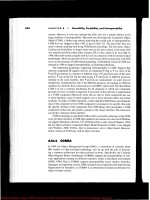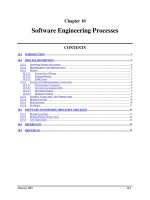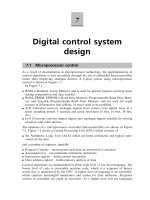SOFTWARE ENGINEERING Chapter 7 –Detail Design
Bạn đang xem bản rút gọn của tài liệu. Xem và tải ngay bản đầy đủ của tài liệu tại đây (10.42 MB, 73 trang )
SOFTWARE
ENGINEERING
Chapter 7 – Detail Design
Jul 2013
Chapter 7. Software Detail Design
Topics covered
• Object-oriented design using the UML
• Design patterns
• Open source development
• More
2
Jul 2013
Chapter 7. Software Detail Design
3
Design and implementation
• Software design and implementation is the stage in the
software engineering process at which an executable
software system is developed.
• Software design and implementation activities are
invariably inter-leaved.
• Software design is a creative activity in which you identify software
components and their relationships, based on a customer’s
requirements.
• Implementation is the process of realizing the design as a program.
Jul 2013
Chapter 7. Software Detail Design
4
Build or buy
• In a wide range of domains, it is now possible to buy off-
the-shelf systems (COTS) that can be adapted and
tailored to the users’ requirements.
• For example, if you want to implement a medical records system,
you can buy a package that is already used in hospitals. It can be
cheaper and faster to use this approach rather than developing a
system in a conventional programming language.
• When you develop an application in this way, the design
process becomes concerned with how to use the
configuration features of that system to deliver the system
requirements.
Jul 2013
Chapter 7. Software Detail Design
5
An object-oriented design process
• Structured object-oriented design processes involve
developing a number of different system models.
• They require a lot of effort for development and
maintenance of these models and, for small systems, this
may not be cost-effective.
• However, for large systems developed by different groups
design models are an important communication
mechanism.
Jul 2013
Chapter 7. Software Detail Design
6
Process stages
• There are a variety of different object-oriented design
processes that depend on the organization using the
process.
• Common activities in these processes include:
• Define the context and modes of use of the system;
• Design the system architecture;
• Identify the principal system objects;
• Develop design models;
• Specify object interfaces.
• Process illustrated here using a design for a wilderness
weather station.
Jul 2013
Chapter 7. Software Detail Design
7
System context and interactions
• Understanding the relationships between the software
that is being designed and its external environment is
essential for deciding how to provide the required system
functionality and how to structure the system to
communicate with its environment.
• Understanding of the context also lets you establish the
boundaries of the system. Setting the system boundaries
helps you decide what features are implemented in the
system being designed and what features are in other
associated systems.
Jul 2013
Chapter 7. Software Detail Design
8
Context and interaction models
• A system context model is a structural model that
demonstrates the other systems in the environment of the
system being developed.
• An interaction model is a dynamic model that shows how
the system interacts with its environment as it is used.
Jul 2013
Chapter 7. Software Detail Design
9
System context for the weather station
Jul 2013
Chapter 7. Software Detail Design
Weather station use cases
10
Jul 2013
Chapter 7. Software Detail Design
11
Use case description—Report weather
System
Weather station
Use case
Report weather
Actors
Weather information system, Weather station
Description
The weather station sends a summary of the weather data that has
been collected from the instruments in the collection period to the
weather information system. The data sent are the maximum, minimum,
and average ground and air temperatures; the maximum, minimum, and
average air pressures; the maximum, minimum, and average wind
speeds; the total rainfall; and the wind direction as sampled at fiveminute intervals.
Stimulus
The weather information system establishes a satellite communication
link with the weather station and requests transmission of the data.
Response
The summarized data is sent to the weather information system.
Comments
Weather stations are usually asked to report once per hour but this
frequency may differ from one station to another and may be modified in
the future.
Jul 2013
Chapter 7. Software Detail Design
12
Architectural design
• Once interactions between the system and its
environment have been understood, you use this
information for designing the system architecture.
• You identify the major components that make up the
system and their interactions, and then may organize the
components using an architectural pattern such as a
layered or client-server model.
• The weather station is composed of independent
subsystems that communicate by broadcasting messages
on a common infrastructure.
Jul 2013
Chapter 7. Software Detail Design
High-level architecture of the weather
station
13
Jul 2013
Chapter 7. Software Detail Design
14
Architecture of data collection system
Jul 2013
Chapter 7. Software Detail Design
15
Object class identification
• Identifying object classes is toften a difficult part of object
oriented design.
• There is no 'magic formula' for object identification. It
relies on the skill, experience and domain knowledge of
system designers.
• Object identification is an iterative process. You are
unlikely to get it right first time.
Jul 2013
Chapter 7. Software Detail Design
16
Approaches to identification
• Use a grammatical approach based on a natural language
description of the system (used in Hood OOD method).
• Base the identification on tangible things in the application
domain.
• Use a behavioural approach and identify objects based on
what participates in what behaviour.
• Use a scenario-based analysis. The objects, attributes
and methods in each scenario are identified.
Jul 2013
Chapter 7. Software Detail Design
17
Weather station description
• A weather station is a package of software controlled
instruments which collects data, performs some data
processing and transmits this data for further processing.
The instruments include air and ground thermometers, an
anemometer, a wind vane, a barometer and a rain gauge.
Data is collected periodically.
• When a command is issued to transmit the weather data,
the weather station processes and summarises the
collected data. The summarised data is transmitted to the
mapping computer when a request is received.
Jul 2013
Chapter 7. Software Detail Design
18
Weather station object classes
• Object class identification in the weather station system
may be based on the tangible hardware and data in the
system:
• Ground thermometer, Anemometer, Barometer
• Application domain objects that are ‘hardware’ objects related to the
instruments in the system.
• Weather station
• The basic interface of the weather station to its environment. It therefore
reflects the interactions identified in the use-case model.
• Weather data
• Encapsulates the summarized data from the instruments.
Jul 2013
Chapter 7. Software Detail Design
Weather station object classes
19
Jul 2013
Chapter 7. Software Detail Design
20
Design models
• Design models show the objects and object classes and
relationships between these entities.
• Static models describe the static structure of the system in
terms of object classes and relationships.
• Dynamic models describe the dynamic interactions
between objects.
Jul 2013
Chapter 7. Software Detail Design
21
Examples of design models
• Subsystem models that show logical groupings of objects
into coherent subsystems.
• Sequence models that show the sequence of object
interactions.
• State machine models that show how individual objects
change their state in response to events.
• Other models include use-case models, aggregation
models, generalisation models, etc.
Jul 2013
Chapter 7. Software Detail Design
22
Subsystem models
• Shows how the design is organised into logically related
groups of objects.
• In the UML, these are shown using packages - an
encapsulation construct. This is a logical model. The
actual organisation of objects in the system may be
different.
Jul 2013
Chapter 7. Software Detail Design
23
Sequence models
• Sequence models show the sequence of object
interactions that take place
• Objects are arranged horizontally across the top;
• Time is represented vertically so models are read top to bottom;
• Interactions are represented by labelled arrows, Different styles of
arrow represent different types of interaction;
• A thin rectangle in an object lifeline represents the time when the
object is the controlling object in the system.
Jul 2013
Chapter 7. Software Detail Design
Sequence diagram describing data
collection
24
Jul 2013
25
Chapter 7. Software Detail Design
Sequence Diagram for Engage Foreign
Character Use Case
:Encounter
Game
freddie:
Foreign
Character
:Engagement
:Engagement
Display
:Player
Character
1.1 create; display
1.2 create
2.1 execute
2.2 change quality values
3.1 Display result
3.2 create









